Brian Teare continues to carve out his place in a distinct poetic lineage, honing a lyric well-learned wherein landscape serves as sounding board for personal reflection alongside engagement with the world at large. The poet’s public voice in Companion Grasses remains quite personal, elegiac and full of harmonic grace. Teare joins a tradition grounded in the 19th century writing of both Whitman and the Transcendentalists, while also harkening back to John Clare and Wordsworth as well as Sufi poet-mystics and hermit-poets of the Far East. A tradition which leads directly to contemporary writing often classified as Eco-poetic in nature. Teare ranks among the vanguard of this scene, not only in terms of the example set by his work, but also his influential presence among today’s younger poets as a roving professor, like so many of his peers, among creative writing programs. (At the time of most or all of this book’s composition, Teare was employed in and around San Francisco. Currently he’s at Temple University in Philadelphia).
Teare’s work is marked by an abiding restraint, a delicacy of paired down materials. These poems speak soft about intimate matters, never going out of their way to grab reader’s attention. They are so adroitly self-contained that there is plenty here to warrant reading after reading, endless explorations of beauty penetrated through by universal sorrow and presented with abiding care by a virtuoso workman. This delicate use of language does not lend itself to any detrimental fragility. The work remains strong, dedicated towards its own discoveries— in the moment of its own revelations. It is a working poetry, a teaching poetry. The focus is upon the use of language to gift onwards higher sensibilities of relation between self and environment.
In “Susurrus Stanzas (Sutro Baths)” the balanced play of sound merges the physical page of the poem with the physical space of a specific place where “fog enters here a stanza / open to weather”. Sutro Baths is a long ago abandoned set of open air ocean baths located at the far Western end of Geary Boulevard in San Francisco along the city’s rocky northwestern coastline known as Land’s End. The cement structures of the baths have been left to crumble as the ocean pounds away upon them. Teare draws attention to correspondences between the poem’s sounding and this fanciful locale which often draws the imagination of visitors.
but coast isn’t
finished yet with
the how-to-touch-it
tide turns waves
to noise shivers
fizzing spindrift
gifted wind sifts
to bricks crashed
crests ended there’s
nothing but rhythm
to hit vision
with image until
the sentence breaks
to let in the there
Teare brings his reading to his writing, a wide array of texts have been sourced for material which has then been embedded throughout the poems. In his “Notes” back of the book Teare acknowledges the poems “actively practice what Jed Rasula in This Compost: Ecological Imperatives in American Poetry calls ‘wreading’—a ‘nosing into the compost library’—” and includes an extensive bibliography spread over four pages and covering dozens of titles.
Sometimes, as most noticeably in “Tall Flatsedge Notebook”, this use of source material takes the form of direct quotes with accompanying citation appearing within the text of the poem itself.
A mile’s hike outside the fence-enclosed vista point
we sat hillside so inside experience I wrote the wrong date
down—March twenty-second—noticing no thought
but things: “when I think they animate my interior speech, [ The Visible
they haunt it as the little phrase.” Ocean-tilted, the whole and the Invisible—
thing leaning green, coastal prairie poised pre-Spring Maurice
a prosody for seeing landscape as aural, ambient trick Marleau-Ponty ]to hear cat’s eye
At other times the source text functions more as a glossy gleaning over which the poem lies afloat on its own terms. The sources either referenced directly or perhaps serving merely as the launching off point for spurring on central components of a stanza or line. Often there is an epigraph or subtitle to further point readers towards a referenced source. This is the case with the middle section of Companion Grasses, “Transcendental Grammar Crown”, a set of fifteen ‘sonnets’ in an excitingly exploded version of that poetic form. In addition to epigraphs from Dickinson, Fuller, Ives, Thoreau, and Emerson, subtitles of poems such as “Field Poetics” and “The Over-Soul” offer further clear indication for rather easily identifying a number of the textual sources at play. In this light, Teare’s bibliography citing exact titles utilized for every section of the book (at times even for individual poems!) appears as an over-Academicizing of a quite natural process of any poet’s practice.
Poets generally read across quite large, varying amounts of material while continually drafting their own poems—along with notes towards poems—as they go. For poets, the activities of reading and writing are hand-in-hand mirror images of each other, at times becoming so blurred as to make it unrecognizable where one activity ends and the other begins. This is one key method by which poets work; how poetry works. Lifting lines from out one’s reading and inserting them verbatim or altering a word here and there is a natural outcome. However, for a poet to be held accountable to the same standards as a literary critic with the expectation they cite sources as though in defense of the poetic work’s argument is a heavy-handed rebuttal of centuries old standards.

Bibliographic lists such as Teare’s are appearing with more frequency in back of poetry books. The tendency is disconcerting yet the practice appears only bound to continue spread. The only way a broad commitment among poets to this practice makes sense is as it is seen from within the academic world as a justification for the increasing presence of the poet-professor. Meanwhile it feels quite out of place among the rest of the poetry reading world. For any committed reader, a poet’s reading and familiarity with certain other works, literary or other, becomes clearer and clearer over time. Often, part of the shaping of the poem is acknowledging from where initial inspiration may have arisen. One of the pleasures of reading comes in joining a company of familiar echoes found within a text while also discovering for one’s own self those less familiar. In the end, the only justification there is for a poem is the poem itself.
Putting aside the idiosyncrasies of Teare’s referencing Rasula’s concept of “wreading” (though it should be said that as a sort of speculative ‘creative criticism’ much of Rasula’s work is top notch), Companion Grasses is both necessary and absolutely accurate poetry of our time. Teare’s work is significantly, to borrow a phrase from the poet Robert Creeley, ‘of use’. Teare’s long memorial poem to his father, “to begin with desire”, reflects how integral reading and writing is to the rest of his living.
often I climb up
& find myself thinkingof my father dead now a year,
how near I was to him
in my ambivalence; he wasthe thing I held away
& so held it closerfor how intently I examined it
thinking myself safefrom influence. I loved him
before I knew anything
about him—the way I lovedHeidegger, Ives, Duncan,
& the idea of California,all four essentially crazy
with ambition, injured,unethical, genius, sweetly
suckered by beauty
& the thought of beauty.so much of our seeing
lies in forgetting the lawsof the fathers, the ones
we were given, & the oneswe choose, as though we look
always at landscape first
through their eyes, a valancingscrim of quotations, before
we blink & see—what?What we love, how we care for it,
is where we live : bay treesso potent today after last night’s rain
our shirts smell still
of leaves we barely brushed by; walkingwith my thumb in a book
to mark a thought
This is a poetry that does not seek distinguish clear differences between how one lives and how one writes, but rather establishes where the two merge, crossing over any formal boundaries. The meshing of reading writing becomes one with emotional living bound within the activity of writing itself. Throughout this book an austere trust in the purity of the poetic act is pervasive. Teare’s honest forthrightness reveals his personal revelations while not reveling in them. Aside from the issue of the bibliography addressed above, there’s no bullshitting, no grandstanding; just the poems.




